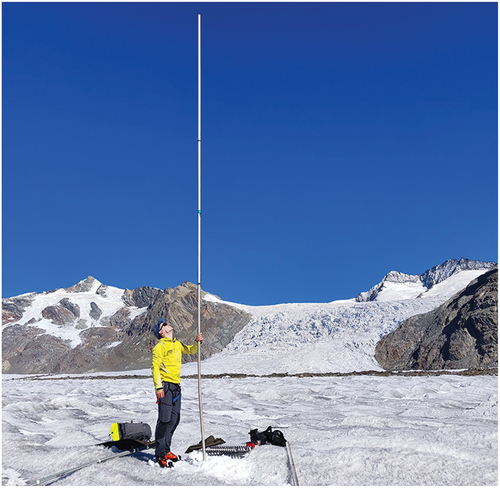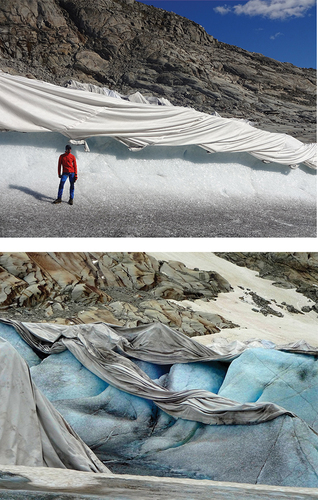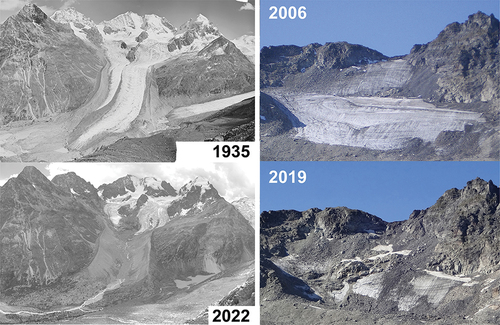ABSTRACT
Glaciers are the ambassadors of climate change. Their worldwide decline has serious impacts on natural hazards, the water cycle, and sea level rise. The monitoring of glaciers documents the increasingly rapid melting, which has culminated in a suite of extreme years—for example, 2023 in North America and the European Alps. Numerical simulations of future glacier change, supported by a large basis of observational data, allow us to understand the enormous changes ahead and prepare us for a world without glaciers. Technical approaches to reduce glacier melting have been developed and are applicable locally—for example, in connection with tourist activities—but they clearly fail at the larger scale.
Glaciers—dynamic masses of ice descending from the mountain tops—have always been fascinating to humankind. They intrinsically belong to the high-alpine environment. Countless photographs immortalize their bright white beauty and the power they radiate. Glaciers have been depicted on oil and parchment for centuries, as if trying to capture their transience. They are constantly moving; under the influence of gravity, the ice generated at high elevation flows downwards and shapes tremendous glacier tongues that are speckled with deep fissures known as crevasses. Sometimes the openings to these crevasses are hidden by a light dusting of snow; subsequently, mountaineers need a lot of experience to accurately judge their exposure to the ice.
Even though glaciers are not living things, they are not lifeless. For many mountain regions worldwide, glaciers function similarly to lungs: They absorb snow in wintertime and “breathe” out water during hot summer days. This glacier water is urgently needed, especially in dry periods.
Glaciers consequently have a relevance that goes far beyond the mountain peaks where they reside. A reduction in meltwater from glaciers would be painful for nature and the global economy: irrigation of fields would be restricted, the temperature and mineralization of rivers would change, and during periods of drought, serious bottlenecks could come into existence for the drinking water supply and for shipping on rivers. In addition, melting glacial ice contributes to sea-level rise and therefore directly or indirectly affects billions of people living near the coast.
Despite, or perhaps because of, their majestic appearance, glaciers can also pose an immediate threat. Glaciers can produce floods and ice avalanches that endanger villages in the valleys. Together with permafrost, glaciers also stabilize mountain flanks and therefore reduce the potential for rock falls and landslides—a role that is becoming increasingly lost.
The so-called “eternal” ice of glaciers tells a long and dynamic story. During the Ice Age, ice sheets covered a large part of the North American continent, as well as Europe. The last time this happened was around 20,000 years ago—a blink of the eye from a geological perspective. Since then, the climate has changed, due both to natural factors and to anthropogenic influences—human-caused factors—which have massively accelerated over the past 100 years (Marzeion et al. Citation2014). As a result, the glaciers are still present, but they are getting smaller every year.
This was already apparent to the earliest glaciologists, who have been monitoring glacier melt for almost 150 years—at some sites without interruption. Since then, many glaciers have massively retreated or have even completely disappeared (). The measurements of glaciologists show a strong imbalance between gains of mass caused by snowfall, and losses caused by melting in all regions, around the globe (Hugonnet et al. Citation2021; Zemp et al. Citation2019). This means that the thickness of the ice, mainly in the lower reaches of the glacier, massively decreases, and the white giants lose more and more of their former splendor.
Years of extremes
The headlines on extreme glacier melting have been omnipresent in 2023: Record-shattering glacier loss in Western Canada and the United States, unprecedented melting events on glaciers all around the Arctic, the European Alps, and so on… What we have witnessed in the most recent past redefines glaciology.
In the case of Switzerland, detailed and long-term monitoring programs showed that 2022 and 2023 offered a “perfect storm” for the country’s glaciers, starting very early in the season. Both years began with a winter that was particularly dry—which meant that there was very little protective snow cover on the glaciers. In addition, southwesterly winds repeatedly brought significant amounts of Saharan dust into the Alps, which settled on the thin snow cover. The resulting dirty, red-yellow snow absorbed more solar energy and melted much faster (Réveillet et al. Citation2022). Finally, summer heat waves containing record temperatures rushed in. The combination of these three factors—little snow cover, overlain with energy-absorbing dust, followed by record-high temperatures—led to unprecedented ice losses that were hardly imaginable up to that point ().
Figure 2. On Konkordiaplatz, in the middle of the Great Aletsch Glacier, over 6 meters (about 19.7 feet) of ice melted down in the summer of 2022—as the view up to the end of the measuring pole impressively illustrates. Photo: M. Huss.

On a countrywide scale, 10 percent of the total remaining ice volume was removed in Switzerland in just those two extreme years. To put that figure into perspective, that is the same amount of loss that occurred over the entire 30-year time period between 1960 and 1990 (GLAMOS Citation2023).
But that’s not all: Glacial disasters such as the glacier collapse at Marmolada in the Dolomites kept us on our toes. On Sunday, July 3, 2022, an avalanche of ice and rock suddenly broke off and buried 11 mountaineers in the Italian Alps. The event came completely unexpectedly; such a break-off had never been observed at this place before. And at first glance, the glacier where the accident originated looks rather tame—a small remnant of ancient ice that was left behind after the retreat of the once-large Marmolada Glacier. Apparently motionless, it lurked inconspicuously in a hollow beneath the summit.
The picture after the event is shocking: The ice is split and cracked, almost as if a bomb had hit. The ice mass lost its grip on the ground, suddenly left its previously stable position and slipped down as a whole. The reason for this was probably a crevasse filled with meltwater that was barely visible on the surface and ran straight through the glacier. The water caused the pressure behind it to continue to increase until the limit of stability was reached (Bondesan and Francese Citation2023). It is extremely unfortunate that the disaster happened when many people were on the mountain. But it is perhaps symptomatic of today’s times, in which nature is used more intensively as a recreation area: in this process, people expose themselves—sometimes unconsciously—to greater risks.
Are more glaciers breaking apart due to the climate crisis? Yes and no.
Heat alone is rarely responsible for a glacier or landslide disaster in the high mountains. Centuries ago, there were already massive ice avalanches and glacial floods, which in some cases claimed lives. It is different today, however, in that glaciers and even whole mountains break apart in places that were previously not considered dangerous.
Although the latest technology now makes it possible to observe unstable areas with high precision and even use this data to make fairly reliable predictions about the timing of an event, none of this is of any use if you don’t know where to direct your eyes or sensors.
Climate change is altering the face of the mountains at a speed we have never seen before. This overwhelms our imagination and our ability to adapt. The melting of glaciers and the thawing of permafrost—which is highly important to stabilize steep rock faces—are constantly creating new situations. Only very few of them are actually hazardous—but just a handful of new, unknown, and unexpected hot spots of instability can pose a major challenge to life in valleys, and to the tourists using the mountains.
Glaciers in a future climate
Can glaciers still be saved? Numerical models are important tools in glaciological research to project the future evolution of glaciers. Such models attempt to describe all processes that are relevant, such as the accumulation of snow, the melting of ice, and the downward flow of mass.
The large data set of past observations, both in situ and from space, documenting glacier retreat over the last decades allows us to accurately benchmark the model for current conditions and then test it against climatic forcing as inferred from global and regional climate models.
The results can be mind-blowing. For example, there are dramatic differences in the computed future of Switzerland’s Great Aletsch Glacier—the largest glacier in the European Alps—(), when one compares a scenario with no measures taken to protect the climate (middle panel) to one in which there is a complete and global implementation of the promises made by the international community at the Paris Climate Agreement in 2015 (right panel).
Figure 3. Calculated retreat of the Great Aletsch Glacier during the 21st century. Left: current extent. Middle: calculated glacier extent around the year 2100 for a scenario without mitigation of climate change. Right: calculated glacier extent around 2100 for a scenario with strong mitigation of climate change (Figure modified from Jouvet and Huss Citation2019).

We do not yet know which of the two scenarios is more likely to occur. To keep this glacier reasonably intact, humanity would have to live a carbon-neutral existence by the year 2060, at the latest—a seemingly tall order. However, many governments have now changed their thinking and set ambitious targets to curb emissions, so that the most favorable development could still be achieved with major efforts and immediate action.
And what humanity chooses to do about climate change will have a big impact. According to the results of a detailed computer model framework, the Great Aletsch Glacier is expected to lose between 60 percent and 95 percent of its current volume by the end of this century (Jouvet and Huss Citation2019). While glacier retreat will continue at a relatively gradual pace until 2050, a significant acceleration is expected in the second half of this century. Several impressive glacial lakes may appear in the deeply incised valley beneath the ice—and their presence could accelerate the retreat even further.
The glacier model clearly shows that the Great Aletsch Glacier will decline significantly even if the climate develops in the most favorable way. In part, this can be explained by a further rise in global temperatures despite a rapid reduction of greenhouse gas emissions. However, a further complication is that the glacier has a very long response time—its extent today corresponds to the climate of around 50 years ago.
Keeping this glacier looking exactly as it does now is not a realistic possibility. Even if temperatures were to immediately stabilize, the glacier tongue would still retreat by over 6 kilometers (about 3.7 miles). To preserve the glacier in its current form, action would have had to been taken years ago, at a time when few were talking about climate change.
Nevertheless, curbing greenhouse gas emissions can still make an important difference: It’s the choice between a complete disappearance of the ice (maybe except for a few meager remnants) and a considerable glacier area remaining at intermediate to high elevations, as seen in the far right panel of . If the latter scenario occurs, the most acute impacts on the water cycle and sea-level rise could still be avoided, and our grandchildren would still be able to admire the beauty of mountain glaciers.
Can technology prevent the melting?
In view of the rapid decline of glaciers, the question arises as to whether the melting can be artificially reduced by technology. This topic finds great resonance in the public (and among apologists for fossil fuels) because it gives the impression of being able to fight against the clearly visible effects of the climate crisis with very concrete measures outside of cutting carbon emissions.
For almost two decades now, more than a dozen glacier-based ski resorts in different countries of the European Alps have covered their ice with white tarpaulins, so-called “geotextiles.” This method has proven to be efficient in reducing the melt locally. Up to 60 percent less snow and ice melts under the fleece material, because it reflects solar radiation and blocks warm winds (Olefs and Fischer Citation2008). The method is used to maintain ski slopes, and an artificially dug ice grotto for tourists. Up to 4 meters of ice (roughly 7.5 feet) can be “saved” beneath the cover each year (, top panel). But the ravages of time are clearly eating away at man’s attempt to combat the effects of climate change: The weather causes the whiteness of the fabric to fade, and the movement of the ice tears it apart. So, after just a few years the geotextiles lose their effectiveness and no longer protect the ice, but only cover it like dirty, old shrouds (, bottom panel).
Figure 4. Top: The effects of glacier coverage with tarpaulins at the Rhône Glacier, Switzerland are short-lived. When first installed, approximately 4 meters (a little over 13 feet) of ice melt had been prevented over the course of 12 months. Bottom: Unfortunately, after a few years, these geotextiles become dirty and torn and no longer have any helpful effect. Photos courtesy of Matthias Huss.

Whether it is worth making such efforts is highly questionable. The artificial-covering of some of Switzerland’s glacier ice only reduced ice-loss country-wide by around 0.03 percent (Huss et al. Citation2021). In other words, although the method works locally and can be worthwhile for tourist activities, the effect at the scale of entire glaciers or mountain ranges is absolutely negligible. To extend such technical approaches to a larger scale, both costs and environmental impacts would be enormous and would seriously violate the principles of sustainability.
A glaciologist’s feelings
The incredible pace of the glaciers’ decline during the last years has redefined our understanding and puts into perspective all information the century-long data series have previously revealed. From a statistical point of view, the extreme events we are now experiencing would be considered almost impossible. But as we know only too well, climate change is shifting the baseline.
The unthinkable suddenly becomes reality, and for better or for worse, we increasingly leave the familiar, comfortable range of past fluctuations and set foot in uncharted territory. The coming decades will show us where this will lead. For our glacier monitoring program in Switzerland, this new reality has been clearly manifested for several glaciers in the last few years: The ice is gone, so the measurements on the glacier have been stopped.
It is a hard-to-describe feeling for a glaciologist to witness this final point, to document it, and to definitively close the folder after decades of observations. On the one hand, there is a feeling of fascination in being a direct witness to these fundamental changes occurring in real time. On the other hand, it’s like losing an old friend. Over many years, I climbed up to “my” glaciers countless times to measure them. It was always the same path—and yet always different, because the rapidly receding edge of the ice reveals something new every time, changing the landscape.
But this process is now finished; the chapter is closed. When hiking down with the last battered poles for measuring ice melt on one’s back, there are certainly moments in which the scientist can become emotional. Once the ice is gone, what remains beneath the bare mountain peaks are slopes with shaky boulders, gruesome scree deserts, and the sound of falling and shattering rocks.
Even though the battle for many small glaciers is lost, it is not yet too late to act and to prevent the demise of the biggest ice masses worldwide. While the disappearing mountain glaciers are an unambiguous warning sign, the full impact of climate change on the planet’s fragile ice reserves only unfolds when the largest glaciers and the polar ice sheets start disintegrating. This is what urgently needs to be avoided.
Acknowledgments
The author would like to acknowledge all colleagues supporting glacier measurements and modeling in Switzerland over the last decades—among others, A. Bauder, A. Linsbauer, G. Jouvet, M. Funk, and D. Farinotti.
Disclosure statement
No potential conflict of interest was reported by the author.
Additional information
Notes on contributors
Matthias Huss
Matthias Huss is a glaciologist and senior scientist at the ETH Zürich, and since 2016 director of the Swiss glacier monitoring network (GLAMOS). His research focuses on past and future changes of glaciers in the Alps and worldwide, and the corresponding downstream impacts. www.glamos.ch; https://vaw.ethz.ch/en/research/glaciology.html; @matthias_huss/X.
References
- Bondesan, A., and R. G. Francese. 2023. “The Climate-Driven Disaster of the Marmolada Glacier (Italy).” Geomorphology 431: 108687. https://www.sciencedirect.com/science/article/abs/pii/S0169555X23001071.
- GLAMOS. 2023. “Swiss Glacier Mass Balance, Release 2023.” Glacier Monitoring Switzerland. glamos.ch/data/massbalance/massbalance_2023_r2023.html.
- Hugonnet, R., R. McNabb, E. Berthier, B. Menounos, C. Nuth, L. Girod, D. Farinotti, et al. 2021. “Accelerated Global Glacier Mass Loss in the Early Twenty-First Century.” Nature 592 (7856): 726–731. https://www.nature.com/articles/s41586-021-03436-z.
- Huss, M., U. Schwyn, A. Bauder, and D. Farinotti. 2021. “Quantifying the Overall Effect of Artificial Glacier Melt Reduction in Switzerland, 2005–2019.” Cold Regions Science & Technology 184: 103237. https://doi.org/10.1016/j.coldregions.2021.103237.
- Jouvet, G., and M. Huss. 2019. “Future Retreat of Great Aletsch Glacier.” Journal of Glaciology 65 (253): 869–872. https://doi.org/10.1017/jog.2019.52.
- Marzeion, B., J. G. Cogley, K. Richter, and D. Parkes. 2014. “Attribution of Global Glacier Mass Loss to Anthropogenic and Natural Causes.” Science 345 (6199): 919–921. https://doi.org/10.1126/science.1254702.
- Olefs, M., and A. Fischer. 2008. “Comparative Study of Technical Measures to Reduce Snow and Ice Ablation in Alpine Glacier Ski Resorts.” Cold Regions Science and Technology 52 (3): 371–384. https://doi.org/10.1016/j.coldregions.2007.04.021.
- Réveillet, M., M. Dumont, S. Gascoin, M. Lafaysse, P. Nabat, A. Ribes, R. Nheili, et al. 2022. “Black Carbon and Dust Alter the Response of Mountain Snow Cover Under Climate Change.” Nature Communications 13 (1): 5279. https://www.nature.com/articles/s41467-022-32501-y.
- Zemp, M., M. Huss, E. Thibert, N. Eckert, R. McNabb, J. Huber, M. Barandun, et al. 2019. “Global Glacier Mass Changes and Their Contributions to Sea-Level Rise from 1961 to 2016.” Nature 568 (7752): 382–386. https://doi.org/10.1038/s41586-019-1071-0.

